Image from a Go-Go newspaper ad, circa 1992. Courtesy of Cheryl Butson.
Article originally published February 12, 2013 by The Grid online (thegridto.com).
The Ballinger brothers – owners of clubs including the Big Bop and Boom Boom Room – were not known for creating sophisticated spots. That changed with the chic, tri-level super-club that brought long line-ups to the Entertainment District in the early 1990s.
BY: DENISE BENSON
Club: Go-Go, 250 Richmond St. W.
Years in operation: 1990-1993
History: Though based in Toronto for less than a decade, the brothers Ballinger made a long-lasting impression. The “Rock ‘n’ Roll Farmers” from Dundalk were entrepreneurs who’d originally opened a variety of venues in Cambridge, Ontario in the late 1970s.
In 1986, Lon, Stephen, Doug, and Peter Ballinger opened the multi-leveled Big Bop club at Queen and Bathurst. The wildly popular hangout would anchor the southeast corner for over two decades, and was the cornerstone of the club empire the Ballingers would build. Their Boom Boom Room, opened at Queen and Palmerston in 1988, was much smaller in size, but was trendsetting with its mix of rock, alternative, house, and queer nights. With a few years’ experience in T.O. and a staff that was willing and able to bounce between venues, the Ballingers soon set their sites on 250 Richmond St. W. for an ambitious new venture.
Richmond and Duncan was not yet an obvious choice of location. After-hours club Twilight Zone had closed just the year before, and Charles Khabouth’s Stilife, located directly across the street, was showing signs of slowing. Beyond these venues, and after-hours rave destination 23 Hop, which would soon open at 318 Richmond St. W., the area was still largely deserted at night.
But with Doug Ballinger at the wheel, the brothers would develop a 14,000 square foot, tri-level warehouse building into one of the most innovative and influential clubs Toronto would experience in the 1990s.
“I had never met anyone as driven and excited about anything as Doug,” says DJ Mark Oliver, who was convinced by Ballinger to leave his residency at Stilife in order to spin five nights per week at Go-Go.
Ballinger custom-designed one floor—what would become known as The White Room—with Oliver’s forward-thinking dance music in mind. Above that would be the large Theatre Room, with a lounge to be built on the first floor, and a rooftop patio—among the city’s first at a nightclub—complete with water fountains and a barbeque hut. This was to be a very different experience from earlier Ballinger creations.
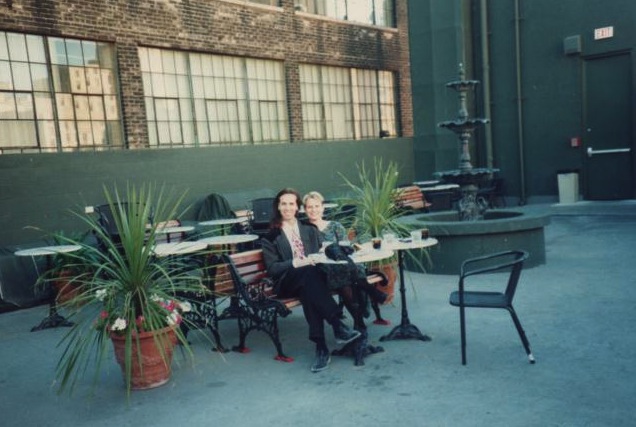
Go-Go manager Steve McMinn with Kim Ackroyd Oka on the rooftop patio. Photo courtesy of Ackroyd Oka.
“The previous Ballinger ventures had been built according to his older brothers’ specs and tastes, but now it was Doug’s chance to shine,” recalls Oliver.
“The Ballingers were all amazingly intelligent in their own unique ways,” says Boris Khaimovich, a Toronto nightclub veteran who worked at both the Boom and the Bop before becoming involved with the construction of Go-Go, where he would head security and, later, manage.
“They were a brilliant team,” describes Khaimovich. “Doug would conceptualize everything, Lon would find a way to finance it, and Steve would build it. [Writer’s note: Peter wasn’t as actively involved.] They were creative, and they were true club owners, with all of the eccentricities involved.”
Go-Go opened to a capacity crowd on July 13, 1990, with the photography of Floria Sigismondi on display.
Why it was important: Go-Go took the Ballingers’ tried-and-true multi-floor format to new heights. It was, at the time, their most ambitious and upscale club project, and its success influenced not only numerous future nightclub builds in Toronto, it also cemented the approach that the brothers themselves would later apply to their New York mega-club, Webster Hall.
“The Ballingers took a building and they made a different club on every floor, which hadn’t been seen here before, except at their Big Bop,” says the straight-shooting Khaimovich during a lengthy phone discussion.
“The Bop was a cash cow; it was like there was a money press in the basement, and they just kept printing it. The Boom was the Ballingers’ first attempt at getting into a smaller, more niche market club. Go-Go was a New York style club in downtown Toronto.”
Khaimovich had himself worked at a number of New York clubs, as well as at Toronto’s renowned Yorkville spot The Copa, during the late 1980s and was impressed by Go-Go.
“There was nothing like it here before. Up to that point, you had RPM, The Copa, The Diamond, and Big Bop as the only big-venue clubs in the city. RPM was in its decline, The Copa was allowed to get rundown, The Diamond did a lot more live music, and the Bop was basically college students getting shitfaced.
“Go-Go was the first club downtown that could easily hold a thousand people, and it was stunning. The lighting was spectacular—we had intelligent lighting—and the sound was solid. The staff was dressed up; they weren’t just wearing black T-shirts. Bodies were being shown, the male bartenders were dressed up, and doormen had to wear a suit and tie.”
Much of Go-Go’s success can be attributed to the club’s stark contrasts, including the aesthetic and feel of each different room. The first-floor lounge was intimate and warm, complete with a large wooden bar and windows looking out onto the street. The spacious second-floor White Room was bold and bright. It was entirely white—the walls, bars, DJ booth, bathrooms, statues, speakers, even the staff’s clothing.
“The White Room was a huge departure from any club of its time,” recalls Oliver, the room’s sole resident for a full year. “Everything was white. Back then, most DJ booths were stuck in a corner of the club. Doug, however, wanted me to be the focal point, so he had the semicircular DJ booth raised eight feet from the floor, and placed in the middle of the east wall.”
From his booth, Oliver would blend rare groove, disco, house, and early techno tracks. He recalls playing loads of early Strictly Rhythm singles, especially Logic’s “The Warning.” Other Oliver anthems heard in the otherworldly room included “Sweat” by Jay Williams, Nightmares on Wax’ “Dextrous,” Sweet Exorcist’s “Testone,” and another early Warp Records’ smash, “Tricky Disco.”
“That room had an ethereal feel to it,” Oliver recalls. ”Not only from it being entirely white, but also from the religious statues affixed to the bars. I could never tell my mum that I swore the Virgin Mary one had real eyes, and was staring at me from across the room all night. Perhaps playing five nights a week in there was a little too much for my sanity.”
One floor up was the Theatre Room, Go-Go’s largest space. During renovations, structural beams had been pulled out of the building and replaced, in order to raise this room’s already high ceiling by an additional six feet. The Theatre Room was painted a rich, dark burgundy, had faux columns on the walls, huge mirrors and multiple bars.
“Where the White Room was meant to be housey, cool and slick, the Theatre Room was meant to be heavy and pounding,” describes Khaimovich.
“The sound was amazing in there,” says James Vandervoort a.k.a. DJ James St. Bass, the Theatre Room’s main resident for Go-Go’s entire history. “There were two massive Electrovoice bass bins, which could knock all the bottles off of the bar. And did!”
Vandervoort, who’d gotten his start as a DJ at the Boom Boom Room, developed his skills and reputation spinning four-to-five nights a week in the raised corner booth at Go-Go. Like Oliver, Vandervoort had his ears tuned to the underground but, as St. Bass, he was also appreciated for his ability to entertain any audience. His crates contained loads of crossover faves, ranging from the likes of Prince, Deee-Lite, and RuPaul to MK’s “Burning,” Ce Ce Peniston’s “Finally,” 2 In A Room’s “Wiggle It,” and numerous Steve “Silk” Hurley remixes.
“I rarely took my eyes off the floor,” says Vandervoort of his approach. “I watched the crowd, to try and make ‘em scream! Your perfect mix and rare tunes don’t mean squat if no one is partying on the dancefloor.”
“I love James St. Bass,” enthuses Khaimovich. “To me, he’s one of the greatest DJs ever. He could make dead men dance because he had a desire to make people dance. There was no ego in James. When you had a combination of Mark on one floor and James on the other on a Saturday night, well you can’t beat that. It was beautiful.”
Initially open Thursdays through Sundays—Wednesday night’s infamous Go-Go Men would open that fall—Go-Go took a few weeks to build a steady clientele, and then caught fire. The Ballingers were also ahead of the curve in programming nights that would appeal to vastly different crowds, and it paid off. While weekends held more mainstream appeal and Thursdays were house-heavy, Wednesdays and Sundays would underscore Go-Go’s broad reach.
“One of my favourite nights was Fast Lane Sundays, with great rock in the Theatre Room, and house in the White Room,” recalls Steve Ireson, a longtime contributor to Toronto nightlife who started working for the Ballingers in 1991.
“I used to drive in from Hamilton every Sunday, before I started working at Go-Go. It was great for me, especially because my ‘straight’ boyfriend at the time was more of a rocker, and I loved both. Surprisingly, the two crowds mixed just fine.”
On Sundays, DJ Vania and host/co-promoter Kevin “KC” Carlisle rocked the Theatre Room. They were also the team behind Boom Boom Room’s wildly successful Sgt. Rocks Wednesdays, and brought the concept to Go-Go.
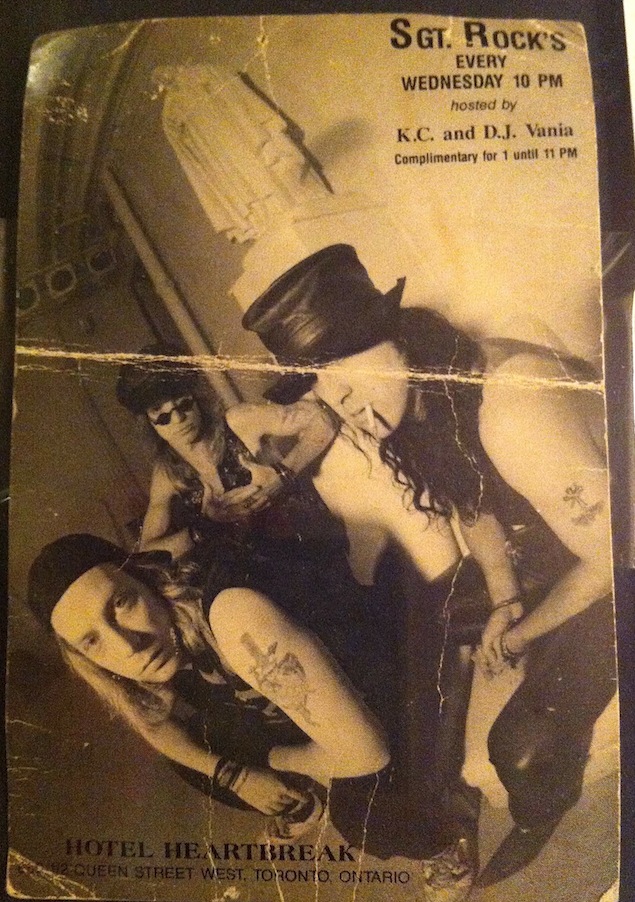
James St. Bass, K.C., and Vania in a Sgt. Rocks promo photo shot at Go-Go. Image courtesy of James Vandervoort.
“Working Sunday nights with Vania spinning was the place to be for me,” says Cheryl Butson, a Go-Go bartender for its full run. “Vania and lighting guy Jimmy Lynch did a great job of taking a big club room and giving it a real dark, underground feel.”
Like Ireson, Butson appreciated Go-Go’s versatility, and the variety of people there on Sundays.
“On one floor there would be house music, with people dancing and dressed to the nines, while on the next floor it was heavy rock, long hair, and leather jackets—with a total mix on the rooftop.”
The single-monikered Vania tells me he’s “remarkably hazy” about his many months of spinning at Go-Go, but especially enjoyed DJing in the more intimate setting of the lounge.
“Honestly,” says Vania, “I had my eye on New York, and wanted to get out of Toronto.” (He would relocate to N.Y.C. to work for the Ballingers late in 1991.)
Vandervoort, who brought the house to Go-Go’s White Room on Sundays, was also the anchor resident at the club’s other signature night: Go-Go Men on Wednesdays. He played in the Theatre Room while Oliver, who’d been a resident at Tazmanian Ballroom’s popular Rock & Roll Fag Bar in the late ’80s, DJed on the second floor.
Go-Go Men built on the success that St. Bass and host/promoter Steven Wong had had with Boys Night Out on Thursdays at the Boom, and would become Toronto’s biggest gay weekly. While Wednesdays took a few weeks to build, they would soon attract crowds of 600-1,000 party boys, fashionistas, warehouse heads, and women each week.
“The thing that gave Go-Go Men that extra boost was that Halloween fell on a Wednesday our first year, and everybody came out for that, in full costume,” recalls social butterfly Wong, then a costume designer and co-promoter of warehouse parties.
“It was very over the top,” he says. “People didn’t dress up in monster outfits or whatever. The thing to do was to emulate the supermodels and what was going on in fashion. If you were going out in drag, you were going out as Linda Evangelista wearing Chanel couture or something. At that point, vogueing and supermodels were very popular, and everyone wanted to be glamorous. Go-Go was very glamorous.”
With visits from fashion-magazine editors, designers including Marc Jacobs and Michael Kors, and gay celebs including Elton John and Rupert Everett, Go-Go Men ran for more than two full years.
“Friends who worked in stores on Bloor Street told me that people would come in and buy special outfits just for their Wednesday nights,” says Wong, now half of womenswear label Greta Constantine. “They’d go in looking like a million dollars, only to get totally trashed.”
“I think Go-Go Men is where I developed my liking for tequila,” shares Ireson who, as a manager, had special duties required of him.
“I would have to help the hot shooter boys into their tequila-belt harnesses. I also have some fond memories of hot-tub parties on the rooftop patio. Go-Go Men was an absolute blast, with line-ups down the street.”
Go-Go, in fact, became notorious for long line-ups, then largely unheard of in the area.
“Go-Go was the first club to bring really big crowds,” states Khaimovich. “On weekends, we had lines all the way around to the CHUM building’s entranceway at Queen and John. Long-weekend Sundays were absolutely insane. We would open up at 8 p.m., and by then, a line-up five-or-six people deep ran to John.”
Hot dog vendors certainly took note.
“That was before all the licensing came in for their carts,” Khaimovich says. “We used to have hot-dog wars outside the club; they used to pull knives on each other, fighting for spots. We’d collect rent money off the hot dog guys for the club—they were making money off of our crowds. I was the head doorman, and worked with a very good-looking farmboy, named Owen Young, at the front door. One night, a hot dog guy didn’t want to pay the club so we took his cart, and put it in the middle of Richmond Street.”
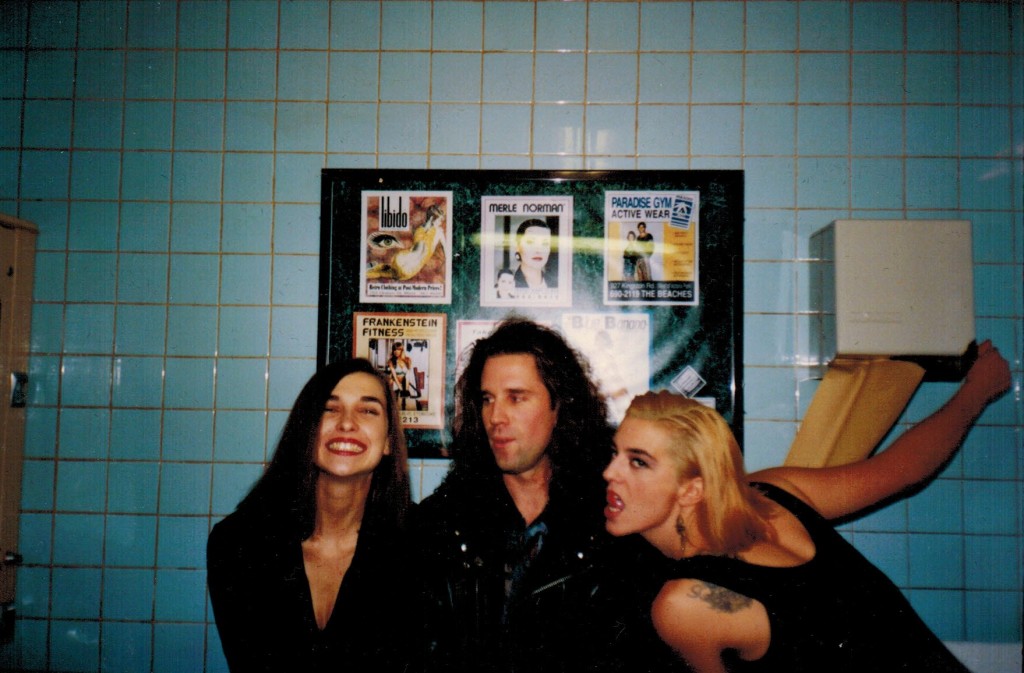
Go-Go Bartenders Cheryl Butson (left) and Allan with cigarette girl Bastian. Photo courtesy of Butson.
Soon, with nightclubs like Klub Max opening around the corner, on Peter, Richmond was busy with traffic.
“Within two to three years, there were many clubs in the area, like Limelight and later Joker,” says Vandervoort. “But after Stilife, Go-Go was the place that anchored what would become the ‘club district.’ Even during the time we were open at Go-Go, I felt like I was living a lyric from Nina Hagen’s “New York New York”—“The newest club is opening up, the newest club is opening up…” Everyone wanted to try and repeat the success from the moment Go-Go opened, it seemed.”
Very few large, mainstream clubs would be such a hotbed for house, techno, and emerging sounds from the electronic underground. Vandervoort—by then also playing 23 Hop, warehouse parties and hosting his Harddrive mix show on CIUT—worked to “remain as cutting edge as possible for a mainstream club.
“I could drop Mike Dunn’s ‘Magic Feet,’ The Underground Solution’s ‘Luv Dancin’‘ or rave-y tunes like Psychotropic’s ‘Hypnosis‘ because I had seen people go nuts for them at underground parties.”
Oliver offers another window onto this exhilarating time in Toronto club history.
“A crew from Windsor showed up at Go-Go one night and handed me a stack of test presses from a brand new label called Plus 8. These early Richie Hawtin and John Acquaviva productions caused quite a stir. A revolution was bubbling under the surface in The White Room, about to explode two blocks away at 318 Richmond.”
Fired suddenly one late summer night in 1991 by “a well-lubricated” Lon Ballinger for not having Ballinger’s specific request on hand to play long after the club had closed (“he demanded I play a Stradivarius waltz.”), Oliver would take his record crates to 318 Richmond and help create local history.
“Leaving Go-Go was probably the most pivotal moment of my career,” says the DJ, now long synonymous with The Guvernment’s Saturday nights. “The following week, Wesley Thuro asked me to take over 23 Hop on Saturdays and, within a few short weeks, Toronto’s rave scene was truly born there.”
“Mark Oliver is one of the greatest DJs that this city has ever produced,” says Khaimovich. “Mark could see the future, and had an edge.”
Who else played/worked there: After Oliver re-located, a then-unknown DJ, Kevin Williams, was hired to play Wednesdays through Saturdays in the White Room. It was his first club residency, and he came heavy with the house and hip-hop.
“Thursdays were my favourite,” says Williams. “They started off as a throwaway night—empty, especially in the White Room. Since I didn’t have anyone to play to, I would go through a stack of new house tracks, most of which I’d purchased that same evening from Play De Record.
“I met Abel Sylla—every house DJ’s fave dancer—and Kenny Glasgow, and they hung out. They helped spread the word, and in a period of four-to-five weeks, we emptied RPM’s disco nights, and brought everyone to the White Room. Not a single flyer was handed out.”
Many other bricklayers of Toronto’s house music community—like Nick Holder, Dino & Terry, Matt C, Peter, Tyrone & Shams, and Eric Ling—were soon seen at Go-Go on Thursdays.
“They brought me into the underground house scene,” credits Williams. “Prior to this, I had no idea you could go somewhere after 2 a.m.
“Go-Go Thursdays also brought a lot of different ethnicities together,” he points out. “The crowd was definitely a new urban mix of young club-heads-to-be.”
At a time when management at many large nightclubs would fully discourage DJs from playing hip-hop, Williams deftly mixed it into his sets.
“One busy Thursday, Steve Ireson came up to the booth during a hip-hop set,” Williams recalls. “Everyone was jumping up and down like kids in a bouncy castle. Black Sheep had already skipped twice, so I started the track over from the top. Steve asked me calmly, ‘Everything okay?’ and then asked matter-of-factly, ‘Hey, do you think you can tone it down just a bit?’ This was odd because he was very liberal, and never asked me to cut the hip-hop, so I wondered why. He said, ‘Well, I was just downstairs, and I can see the ceiling buckling up and down.’”
DJ Mark Falco was also a key resident later into Go-Go’s history. Having played at popular gay clubs like Komrads and Bar One, Falco was initially hired to work lights in the Theatre Room, complementing the sounds of St. Bass at Go-Go Men. Soon after, Falco would DJ in the White Room on Wednesdays, and eventually played his then-signature tunes, like Aly-us’ “Follow Me,” Kym Sims’ “Too Blind To See It,” and Liberty City’s “Some Lovin’” several nights a week until the club’s close.
“Standout Go-Go memories include Stephen Wong and Rommel doing runway in knockoff Mugler motorcycle corsets, and other White Room happenings,” says Falco, a sought-after DJ to this day. “I always loved that room on men’s night for the breakout bus-stop lines, and for the fierce vogue/runway action that would happen late at night.”
Vandervoort adds some cherished moments of his own, experienced at Go-Go primarily on Sundays.
“I met a lot of heroes, like Juan Atkins and Larry Heard a.k.a. Mr. Fingers, who was in on a Sunday night with Robert Owens. Roger S came and danced to my set! And I had a great chat with Neil Tennant from Pet Shop Boys, who had a private party in the White Room one night after their concert. He came up to the booth and we chatted between mixes for half an hour. At one point, I said, ‘I think I have one of your favourite records here in my disco crate,’ and pulled out Nuance’s ‘Love Ride.’ He howled, and said, ‘You know, we based our whole first album on that track.’ You can’t ever forget what it’s like to have those kinds of heroes in your DJ booth.”
But it was not all fun ‘n’ games for Go-Go DJs and staff. Working for the Ballingers could be challenging, by many accounts.
“So much of Go-Go was up and down—the stairs, the crowds, the fun, the not-fun,” admits Vandervoort. “Never for me before or since has a club so perfectly fit the cliché of ‘It was the best and worst of times.’ I knew I was fortunate to work so much but, also, if you worked there, you knew how many people came and went, and under what strange circumstances.”
“The Ballingers were notorious for firing their managers,” confirms Ireson. “I alone was fired three times—and hired back twice.”
“For all their faults, when they were sober, the Ballingers actually treated their staff spectacularly,” offers Khaimovich. “When they were drunk, they were erratic. If they kissed your forehead, you’d either get a raise or get fired. I was fired three times by them—twice hired back, the first time with a big raise.”
As evidence, many Go-Go staffers also worked at other Ballinger clubs, including original managers Mike Ibrahim, Anthony Rofosco, and Steve McMinn. Bartenders including Butson, Cristy Byrom, and Drew Rowsome also worked other Ballinger clubs, as did bar-backs Jeremy Markoe, Barry Gerreau, and “Super Dave” Baker. (Markoe even followed the Ballingers to New York, where he now resides.)
Many other members of the Go-Go staff became familiar faces on this city’s nightscape. Bartenders Daniel and Michel Quintas would later partner with Khaimovich to open Insomnia on Bloor, while Rosemary Martin and Holly Batson later worked at The Guvernment, and door man James Benecke opened both the Kat Club and Apothecary Music Bar.
Most interviewed for this story mention that the Go-Go team was tight.
“Some of my fondest memories of Go-Go are of how we, as a staff, would go out all together after closing up,” recalls Ireson. “We’d show up at boozecans or warehouse parties as a crew.”
After Ireson was fired the final time, he went on to manage at clubs including Factory and OZ, where both Williams and Vandervoort would DJ, as well as 5ive and CiRCA. Go-Go alumni was hired at each venue. Ireson is now co-owner (with husband Chris Schroer) of deli-café The Hogtown Cure.
Vandervoort summarizes a statement expressed by many interviewees, albeit from a DJ’s perspective.
“I loved the first two years at Go-Go and had some of my best and most cherished nights there. It was also DJ boot camp—a total woodshed workout. I was very burned out and ready for a change when the end came, and I never worked exclusively in one club or for one owner ever again. It was definitely a case of all my eggs in one basket, and, trust me, they cracked!”
Despite requests, Lon Ballinger declined to comment for this story.
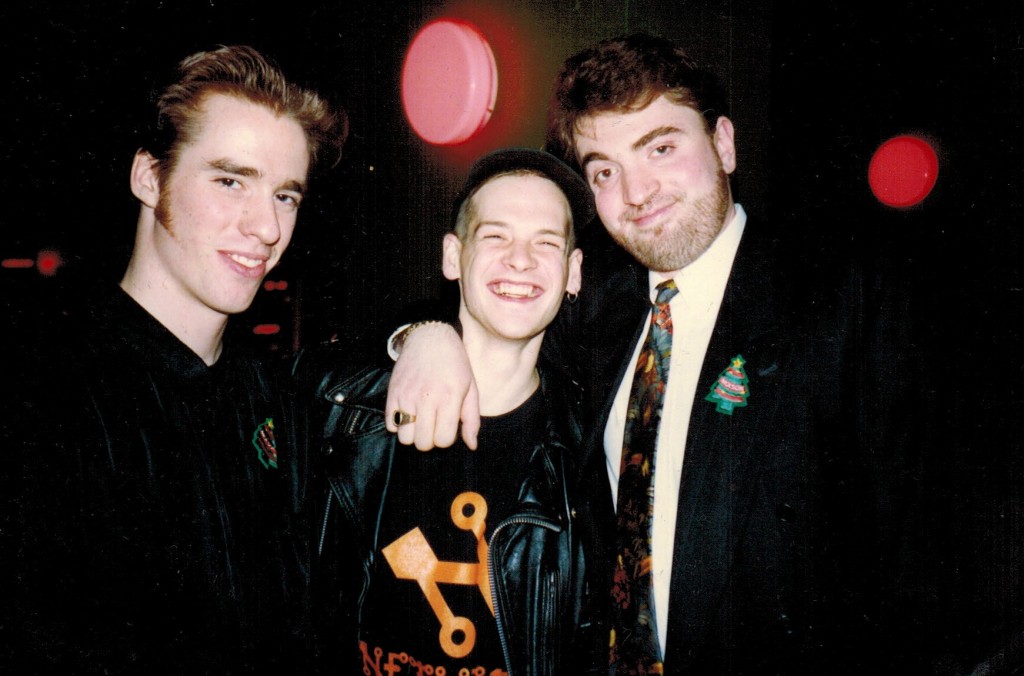
Steve Ireson (left) and Boris Khaimovich (right) with busboy David Baker.
Photo courtesy of Cheryl Butson.
What happened to it: “Go-Go was like a comet,” says Khaimovich of the club’s trajectory. “It came out of nowhere, was shining so bright that you would get blinded, and it died really fast.
“Go-Go started crashing within two years. We’d been doing such high numbers that I think everybody had seen it, done it, and moved on to something else. By that point, other spots had opened up.” (Khaimovich himself would go on to manage Limelight and now resides in Northumberland County where he indulges his love of horses.)
“Also, after about a year-and-a-half or so, the Ballingers started spending a lot more time in New York, on building Webster Hall. Their focus changed, and honestly, Webster Hall sucked the money. You could practically see suitcases leaving Go-Go and going to Webster Hall.”
Attempts to revive Go-Go included painting the White Room and renaming it The Black Angel Room. The Ballingers’ attention was greatly divided. Not only had they purchased New York club The Ritz in 1990, and begun the massive undertaking of re-opening it as Webster Hall, they’d also bought The Courthouse on Adelaide East, and Mississauga all-ages club Superstars, which they opened as The World in June of 1992.
“The Ballingers were very aggressively building an empire, and I think they got spread too thin,” says Vandervoort, now a DJ who plays selective gigs, including the Black Crack Funk Attack monthly, and works by day in student support services at a city college.
“To their credit, they got what they wanted with Webster Hall,” concludes Vandervoort. “To my mind, that venture was built and financed off a lot of people’s blood, sweat, and tears at Go-Go and the Bop.”
Vania, who DJed at Webster Hall for its first six years, returned home in 1998, and now spins at venues including the Bovine Sex Club on Fridays.
“After seven years in New York with the Ballingers, it became a little wearing. But the last time I was there, they were getting keys to the city, and Webster Hall had been designated a historic landmark. Americans love a success story.”
Go-Go closed quietly in the summer of 1993. 250 Richmond St. W. soon re-opened as Whiskey Saigon where Go-Go veteran DJs including Oliver, Williams, Falco, and Vania all played. Joe Nightclub followed. The building now houses the head office of Bell Media’s Radio operations, including the studios of CHUM-FM and Flow 93.5.
Thank you to participants Boris Khaimovich, Cheryl Butson, James Vandervoort, Kevin Williams, Mark Falco, Mark Oliver, Steve Ireson, Stephen Wong, and Vania, as well as Cristy-Jane Byrom, Jeremy Markoe, Kim Oka Ackroyd, and LAEddy.

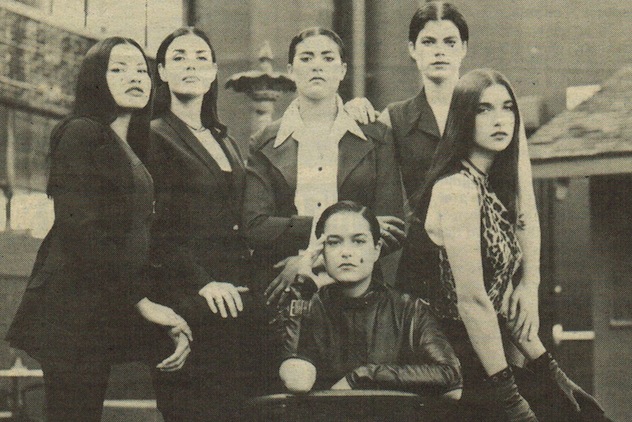

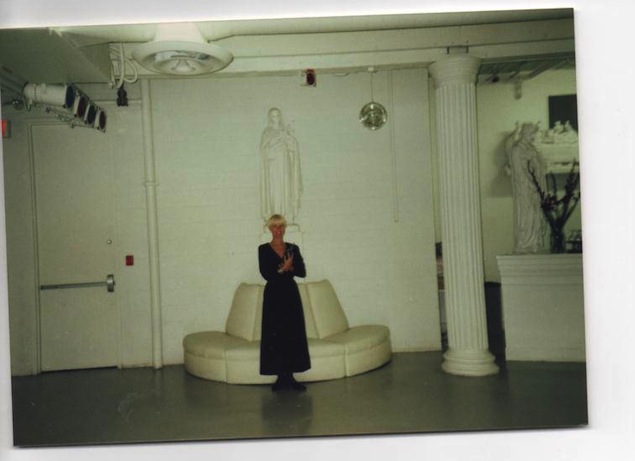
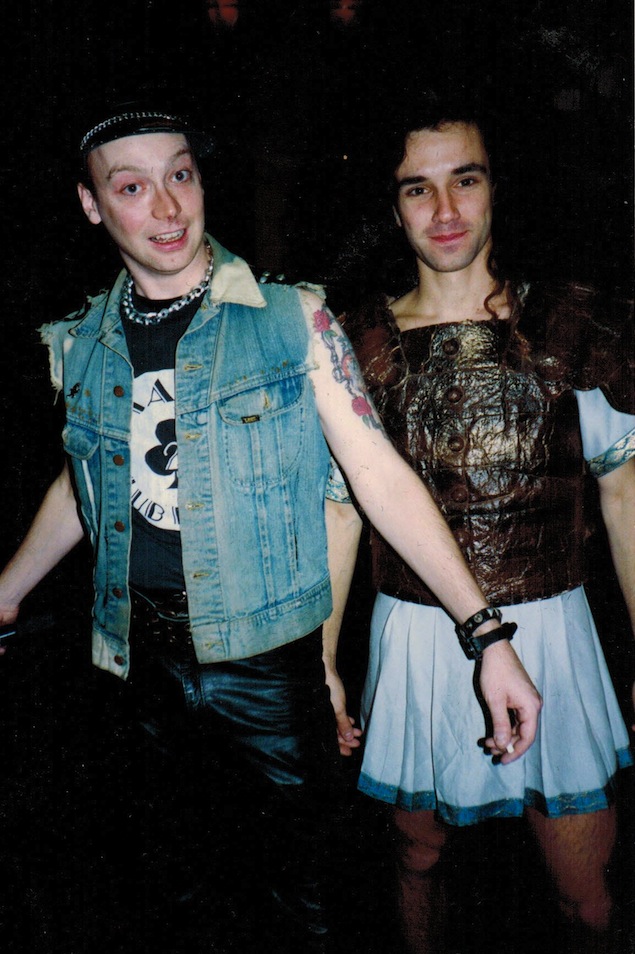
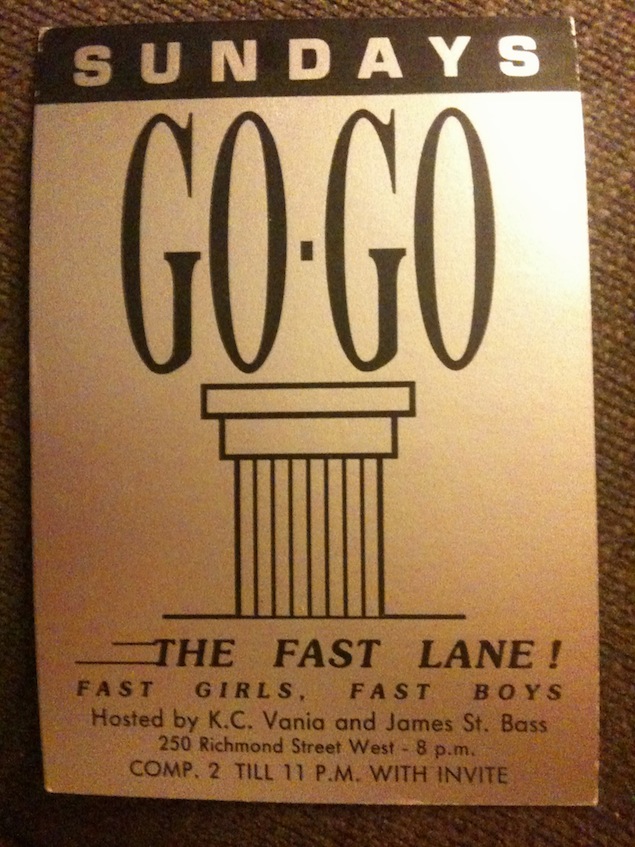
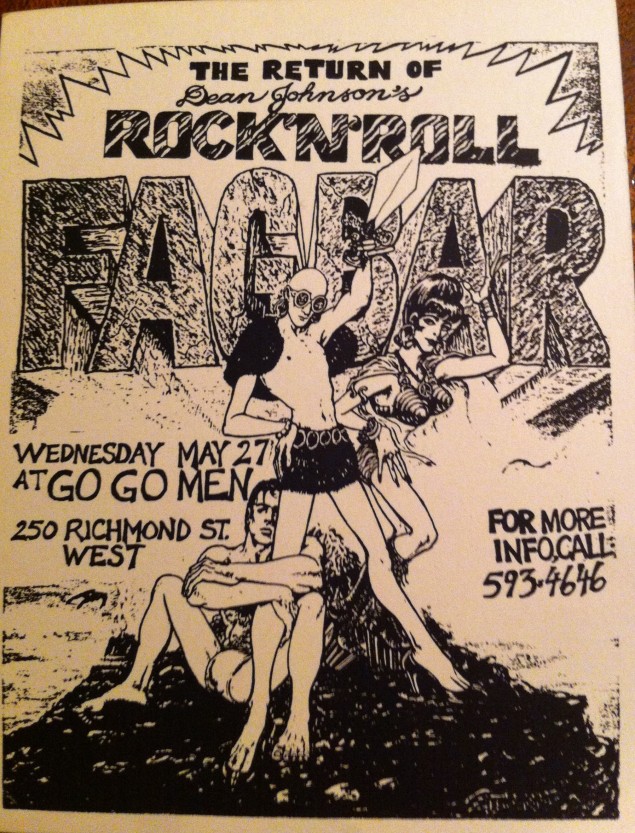
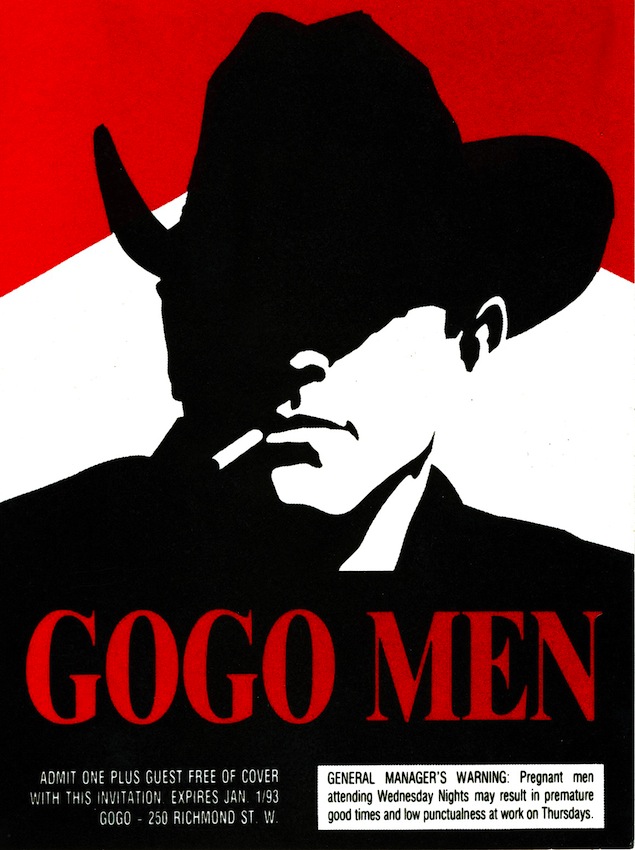
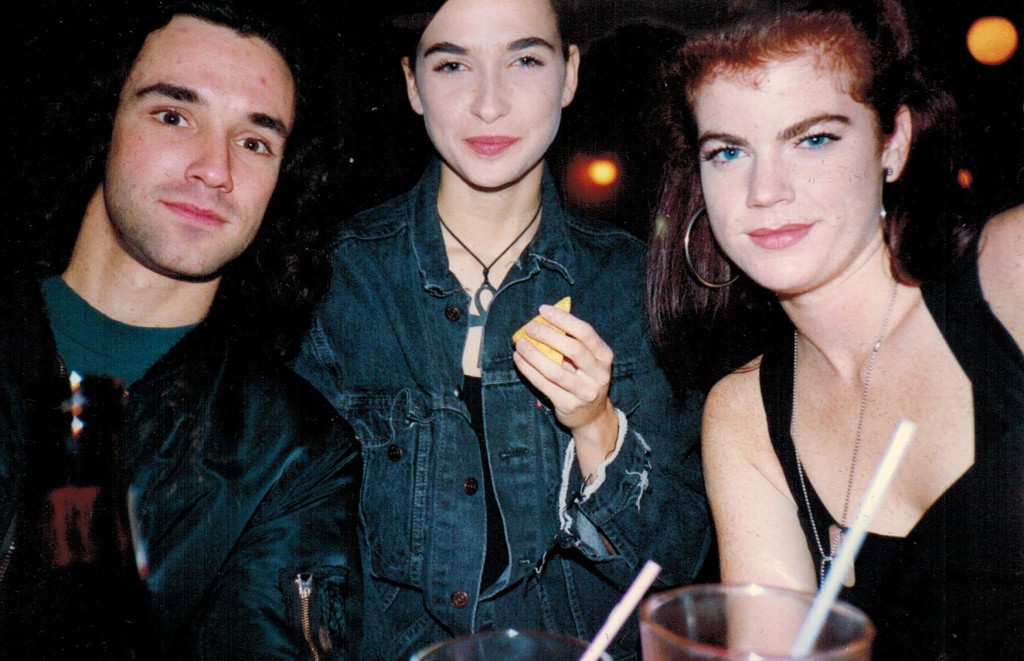
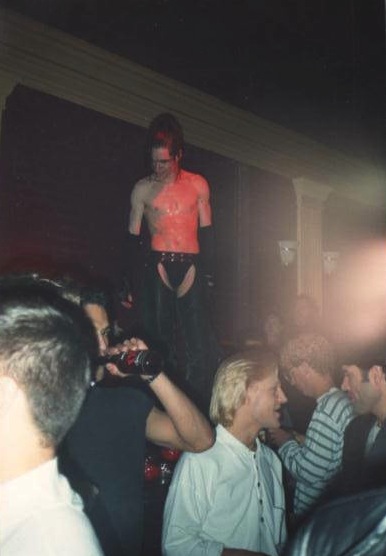
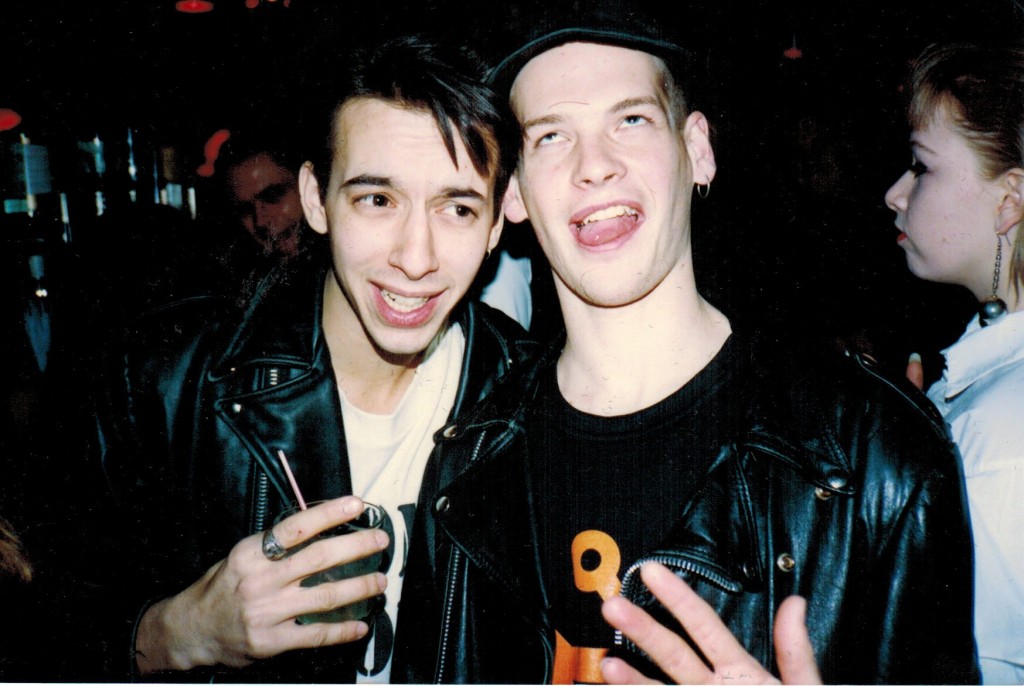
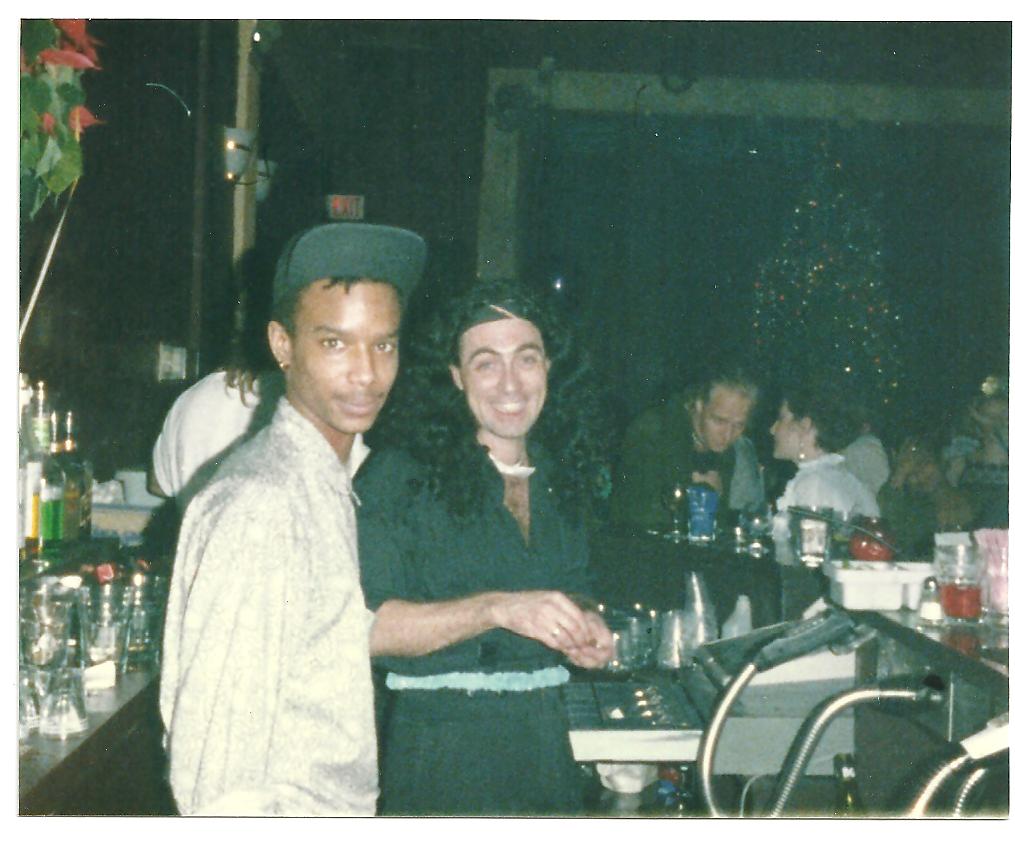
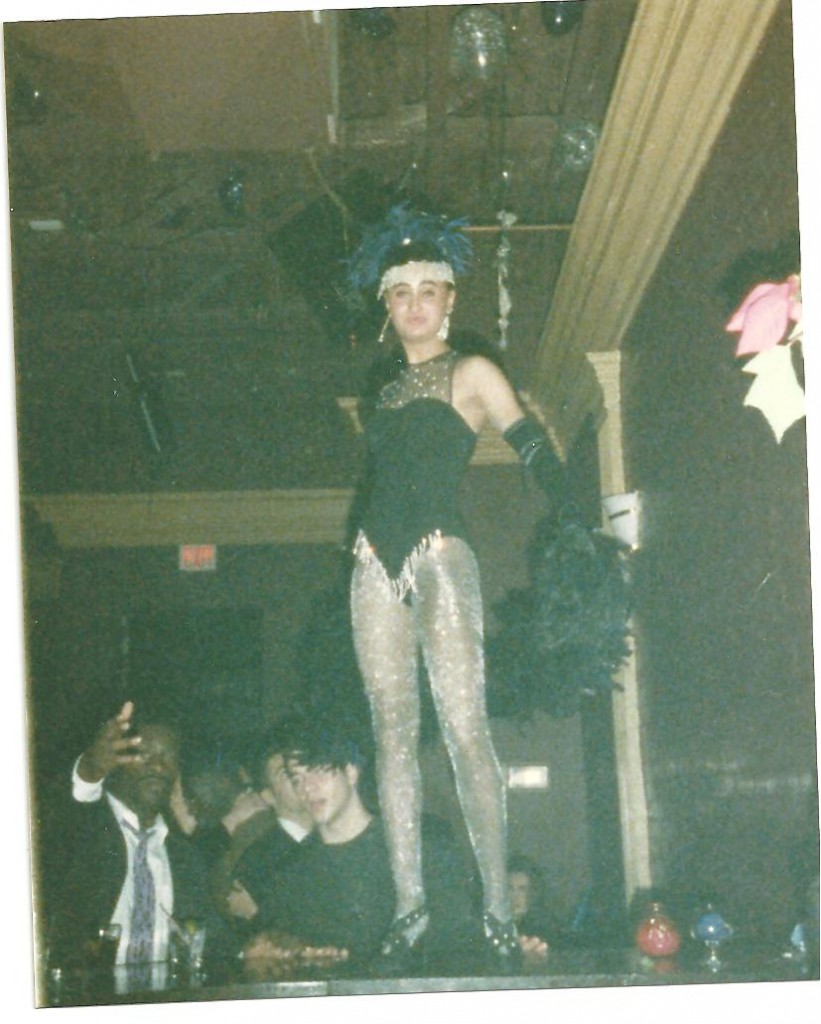
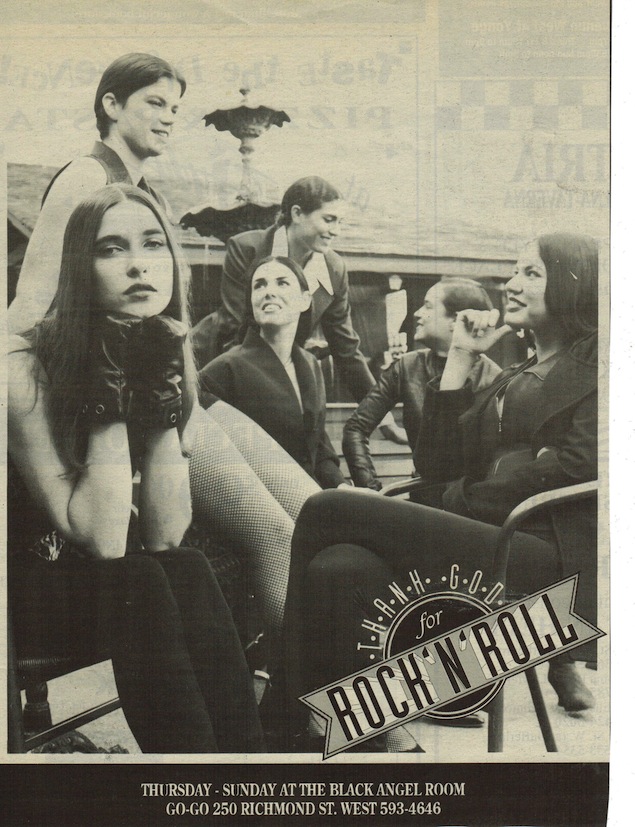
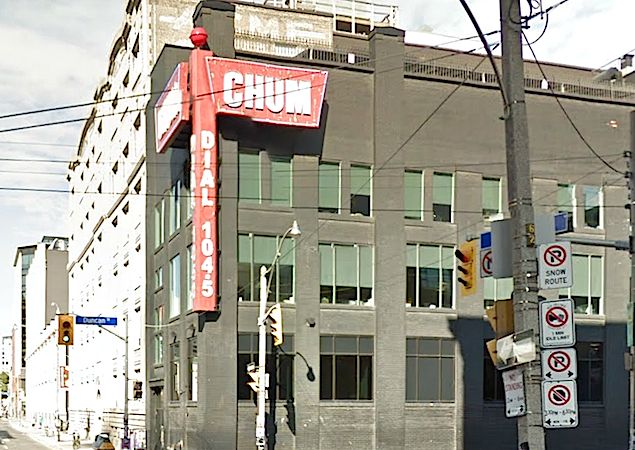
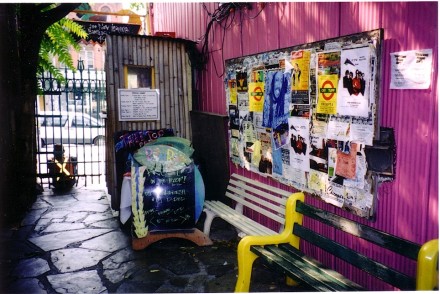
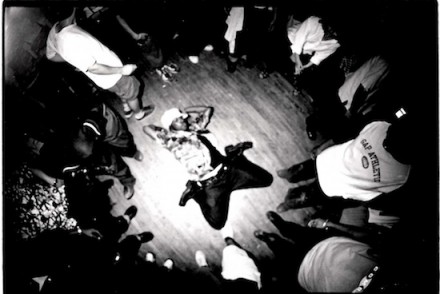
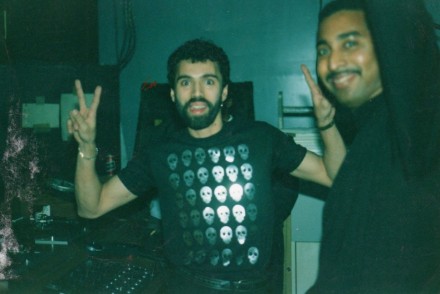

8 Comments
I remember Go-Go was the most elegant club at the time in Toronto. The bouncers wore tuxedos, the ticket booth girl wore an evening dress and greeted you with a smile behind a desk that had an orchid in a vase. There was also an art gallery downstairs by the coat check area,something I had never seen before in a nightclub.
The white room was a fascinating dance space, I remember the white statues and the sounds of underground tracks being played. Later, we would make our way to the Theatre room to dance the night away.
I miss this club and the Toronto of this bygone era, forever feeling a bittersweet longing.
I worked as the lights jockey with James up in the Theatre Room. I was there the night Neil Tennant from Pet Shop Boys had a private party in the White Room. I remember going down to see him and said hello. I was drunk (as usual) and asked him to come with me upstairs and introduce him to my ex-girlfriend at the time, she freaked out. I then asked him on up to our booth and hang out for a bit. It was an amazing night. My most cherished memories was going out with the staff after hours to all the clubs downtown and dancing until late mornings. Good times, I miss those days
Whisky Saigon/ Go Go went to both and often but Whisky was where my life turned around a complete 180. met a girl did not want anything to do with her. I was pissed at letting this really hot girl I had spent the night dancing with get away……I was leaving when I lost 2 of my friends who were riding back with me. I had to be at school ( teacher) for 8:20 it was now like 1 am and I was pissed off. go back to the second floor and find them working these 3 girls and I got roped in to staying till close. to top it off we ended up walking them back to their Holiday Inn at harbourfront I got home at 4:45 am…. I called in and said SICK need a sub. But i did get the girls number. we dated for 3.5 years engaged for 18 months travelled the world together and we still are ….separately I may add 97 countries and countng. But had not been for that night in Whisky Saigon I’d be still teaching somewhere in Ontario bored out my freaking head. I’m nearly 50 and I still wish there would be a night where Whisky or the Go Go for that matter would pop back up with the music of those days just 1 more night. Gimme Martin Streek and Paul Dinghra, It was Magic.
I know this is an old post, but I had to reply – what a great story and fun memories made at Whisky Saigon. SO many fun times there. When I think of my time in Toronto, WS is paramount to the best memories.
We enjoyed the article very much and the comments and observations made by the staff and a few others where fun to read ….We learned a lot in Toronto,and Cambridge, and even where we grew up in our old farm villages and towns of Corbetton and Dundalk and Orangeville as well ….take care Toronto and come see us at Webster Hall in New York City sometime ….thank you for the memories ….The Ballingers …
Just wanted to say I loved Ballingers in Cambridge and went there as many nights as they were open. I danced my ass off, I was always on the VIP and dated one of your waitresses. The doorman in the Berret and Sammy at the Bar. Parked across the road and ran across. Thank you Ballingers
What a great essay ! SO many memories ! AND thank you oh so much for the big ups and the shout outs unto my home base wherein i used to work everynight as a promoter for BAR ONE w/ Basil /Judy / Virgil and i was also involved as a gossip columnists for the newspaper called OUT in Canada for Shawn Vannasa ~!~ NOT MANY EVER MENTION BAR ONE OR KOMRADS as too many hated us back then for packing them in like sardines but oh my did we have so much fun and all we ever charged was 5 bucks to get inside at the door or 10 after 1 am ! LOL ! The younger promoters are behave as if all OF THIS DID NOT EXIST before their lil parties like Wayla or Church of Church ) OMG !) came along trying so hard to rekindle and redo and remake the 90s warehouse ‘vibe’ again. One set of parties i went to last pride was PITBULL and i was so annoyed at the price of everything and the attutides so very very different than anything mentioned in this remarkable essay ! THANK YOU so much for the consideration and big ups cause after the GO GO and or Boom Boom Room closed for the night at 2 you all FOLLOWED GUYS like me unto isabella by the HOUSE OF LORDS unto BAR ONE ! WOW ! everyone was there ……Gilles Bellengier , David HYnes from the Kurbash or the Lizard Lounge……even the Betty Page Social CLUB ….all the industry staff came in from other places to witness the fancy pants balls on the dancefloor and the sheer afterhours insanity ! LOL ! This is when it first became fashion to wear DROOPY DRAWERS lol ! ITs was so amazing to show up with no money and still have so much FUN ! This is SURE not the scene or case today on such a large scale…as everything shrunk like a digital chip or bit mark or j peg on the html ! LOL ! I remember at about 3 am the sheer joy and energy on the dancefloor I HAVE NOT SEEN IN TORONTO ANYWHERE SINCE THOSE DAYS AND HAZE of dry ice ! LOL !
All comments in the string below have been republished from their original appearance on The Grid website. We’re including the readers’ comments as they add to these Then & Now stories. We look forward to reading new comments here as well.
Shaun
Whiskey Saigon!! That was the club to be at for Martin Streak’s Retro 80′s night. The best, and I mean THE BEST! Miss the club – miss Martin Streak. 12:04 pm on May 6, 2014
Dom
This is a great series. Brings back a lot of memories of when I was in my 20′s and partying. Back when I was going to clubs in the early 2000′s, the club of choice for me and my friends was Fluid Lounge. Every night was amazing but Saturday’s and especially Sunday’s House music night were the best. It had an awesome crowd too. Everyone just listening to the music and having a good time. You should do a piece on it. 3:38 pm on February 25, 2013
Anonymous
Kat Club Friday nights! Kevin Williams and guests, unbeleivable. 3:49 pm on February 22, 2013
Damien 74
You should do one on the ill-fated Meow Lounge sometime 2:47 pm on February 22, 2013
jay_sands
I also love these features. I came of age during the mid-to-late 90s, and I cut my teeth on the big parties by the likes of Syrous, Dose, Better Days and Nitrous. Later, when it was time to move the party into the clubs, I and my friends fell in love with Industry, System Soundbar and Roxy Blu. But some of these pieces make me wish that I could go back and experience some of what was going on back when my bedtime was still 9pm. 3:33 pm on February 19, 2013
Patrick Jameson
Love these stories. Thanks very much. I seem to recall that a bar called Atlas was a bit later than this. I think it would make a great story. 8:59 pm on February 12, 2013